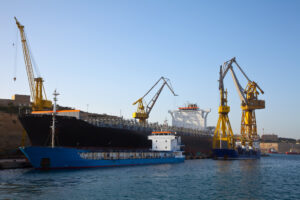Introduction
Dry bulk shipping is the transportation of commodities in large volumes, such as iron ore, coal, grain, and other minerals, typically packed loosely in bulk carriers. The dry bulk shipping industry plays a vital role in the global economy, facilitating the transportation of goods from one region of the world to another. Despite its importance, the dry bulk shipping industry has faced several challenges in recent years, including fluctuations in freight rates, changing regulations, and increased competition. This blog will examine these challenges and provide insight into how players in the industry can navigate them.
Challenges of the Dry Bulk Shipping Industry
Volatile Freight Rates
One of the significant challenges in the dry bulk shipping industry is the volatility of freight rates. Freight rates are the prices charged for shipping goods by sea. These rates are determined by supply and demand and can fluctuate widely depending on various factors. The shipping market is cyclical, and freight rates can swing from highs to lows within a short time. For instance, in 2019, the freight rates for the Capesize vessels (the largest class of bulk carriers) hit a four-year high of around $34,000 per day. However, in 2020, the rates plummeted to $2,500 per day due to the COVID-19 pandemic, causing a decline in demand for commodities and shipping services.
To navigate the volatility of freight rates, dry bulk shipping companies must be flexible and adapt to changing market conditions. They must be able to adjust their capacity to match demand and take advantage of market opportunities. One way of achieving this is by diversifying their fleets to include different types of vessels that can carry various types of commodities. For example, if the demand for iron ore transport declines, the company can switch to transporting coal or grain instead.
Regulatory Changes
The dry bulk shipping industry is highly regulated, and changes in regulations can have a significant impact on the operations of shipping companies. In recent years, there have been several regulatory changes aimed at reducing carbon emissions and improving the sustainability of the industry. For instance, the International Maritime Organization (IMO) introduced regulations that require shipping companies to reduce their greenhouse gas emissions by at least 50% by 2050. This presents a significant challenge to dry bulk shipping companies, as they must invest in new technologies and adopt new practices to reduce their emissions.
To navigate regulatory changes, dry bulk shipping companies must stay informed about new regulations and take a proactive approach to compliance. They must invest in new technologies and practices that reduce their environmental impact, such as using more fuel-efficient vessels, adopting alternative fuels, and implementing energy-saving measures onboard their vessels. Companies that fail to comply with new regulations risk facing penalties and reputational damage, which can harm their business operations.
Increased Competition
The dry bulk shipping industry is highly competitive, with many players competing for a share of the market. The industry’s competitiveness is driven by several factors, including the availability of vessels, the cost of shipping, and the demand for commodities. The industry is dominated by a few large players, but there are also many smaller companies that operate regionally or specialize in specific commodities.
To navigate the increased competition, dry bulk shipping companies must focus on differentiating their services and offering value to their customers. They must invest in quality vessels, adopt new technologies that improve efficiency and reduce costs, and provide excellent customer service. Companies that can provide a reliable and cost-effective service will be better positioned to succeed in the highly competitive market.
Technological Changes
The dry bulk shipping industry is undergoing significant technological changes, with new innovations emerging that are transforming the industry. These technological changes include automation, artificial intelligence, and the use of digital platforms to streamline operations. While these changes offer many benefits, they also present challenges to shipping companies, as they must invest

